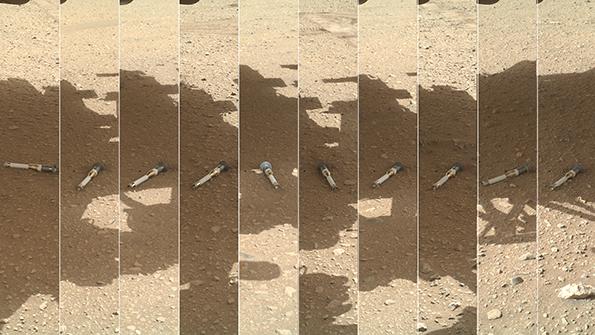This article is published in Aviation Week & Space Technology and is free to read until May 04, 2024. If you want to read more articles from this publication, please click the link to subscribe.

Sample collection tubes, retrieved and packed by NASA’s Mars Perseverance rover, await a return to Earth. The program’s funding is uncertain.
NASA is adjusting its spending outlook after budget caps nixed the Biden administration’s requested $2.3 billion hike for fiscal 2024 and sharply limited the White House’s ask for next year.
Under the agreement hashed out by congressional appropriators and signed by President Joe Biden on March 9, NASA will receive $24.9 billion for the year that began Oct. 1, 2023—$509 million less than in fiscal 2023. The administration had asked for $27.2 billion.
- Spending on Mars Sample Return to be determined
- Chandra X-Ray Observatory faces steep funding dip
- Artemis funding remains stable
At 2% less than what NASA received for fiscal 2023, the 2024 budget marks the first year since 2013 that the agency’s budget failed to grow.
For fiscal 2025, the White House is trimming its request to $25.4 billion, the same amount NASA received in fiscal 2023. It is also about $2.3 billion less than the projected $27.7 billion fiscal 2025 request anticipated prior to passage of the Fiscal Responsibility Act, which capped nondefense discretionary spending for fiscal 2024 and 2025.
“We’re not going to get out of this hole until you finish both fiscal years, ’24 and ’25,” NASA Administrator Bill Nelson told reporters on March 11.
While today’s budget environment is sobering, Nelson, a former longtime senator from Florida, said NASA faced a far more dire situation a decade ago. “This is mild by comparison,” he remarked.
NASA’s budget should begin to grow again in fiscal 2026, but in the short term, hard choices loom.
The agency’s efforts to expand human space exploration beyond low Earth orbit (LEO) under the Artemis initiative should remain mostly on track, although budget documents released March 11 show the third crewed mission on the surface of the Moon, Artemis V, will be delayed a year to 2030. That is to be the first mission using Blue Origin’s Human Landing System (HLS). Artemis III, slated for late 2026, and Artemis IV, expected in 2028, are to use the HLS provided by SpaceX.
Overall, NASA’s exploration programs—including the Space Launch System, Orion spacecraft, HLS programs, new spacesuit development and other elements of the Artemis initiative—would receive $7.6 billion. That is about the same as what NASA plans to spend this year and some $500 million below previous projections.
Planetary science programs face a bigger squeeze. Rather than the anticipated request of $8.4 billion for science overall, the White House is asking for $7.6 billion in fiscal 2025. Of that, $2.7 billion would be allocated to planetary science, which received $3.2 billion in fiscal 2023 and $2.7 billion this fiscal year.
Even before the latest budget rollout, NASA was revamping its flagship Mars Sample Return program, which an independent advisory panel last year determined to be unrealistically priced and scheduled. Whatever NASA decides to do with the program, overall spending for planetary science is not expected to change, so any additional funds would have to come from other programs, NASA Associate Administrator for Science Nicola Fox and Planetary Science Division Director Lori Glaze said during budget rollout town halls.
An early alarm sounded for NASA’s 25-year-old Chandra X-ray Observatory: Budget documents show a drop in spending for telescope operations— to $41 million in 2025 and $5 million in 2029 from $68 million in 2023. “The Chandra spacecraft has been degrading over its mission lifetime,” agency budget documents state. “The reduction to Chandra will start orderly mission drawdown to minimal operations.”
Funding for the Hubble and James Webb observatories and preparations for the upcoming Nancy Grace Roman Space Telescope infrared observatory are stable.
The 2025 spending plan proposes that NASA cancel the Geospace Dynamics Constellation heliophysics science mission and revamp a series of Earth System Observatory projects.
Beyond that, NASA’s Commercial LEO Destinations (CLD) program faces cuts. The program supports development of privately owned space stations to take over NASA’s LEO research program after the International Space Station’s planned deorbit in the 2030s. The CLD, which received $228 million in fiscal 2024, had been expected to receive $229.6 million in 2025, but the budget ask for 2025 is $169.6 million.





